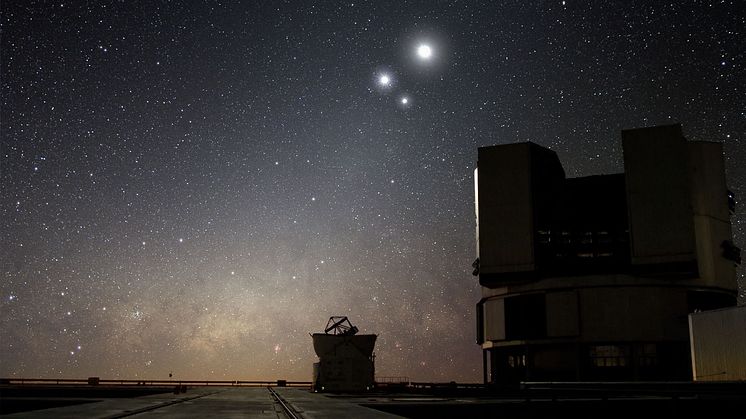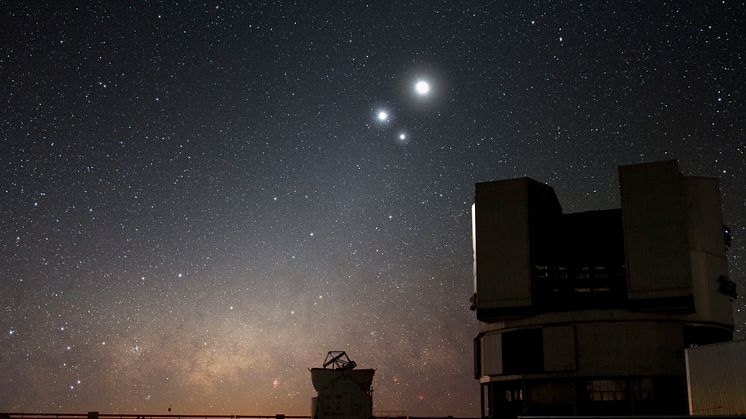
News -
Water and extreme winds detected on exoplanet
On the exoplanet WASP-127b, over 500 light years away, wind speeds can reach 33,000 kilometres per hour, according to a study by an international team of scientists. This is the first time winds of this type have been detected and it has been possible thanks to an instrument partly built at Uppsala University. The study is published in Astronomy & Astrophysics.
Exoplanets are planets that orbit other stars in other solar systems. Because they are so far away, until a few years ago astronomers could only measure their radius and mass. Thanks to new, advanced instruments, it is now possible to study the climate of planets far beyond our solar system.
Gas planet with extremely strong winds
In the current study, the researchers looked at the exoplanet WASP-127b, which is of a type known as a ‘hot Jupiter’ due to its large size and proximity to its host star. It is over 500 light years away and is composed entirely of gas. By comparing several images of the planet, scientists have been able to see how the atmosphere moves over time.
“We have detected extreme winds of 33,000 kilometres per hour. This is the first time we have seen winds of this category on an exoplanet. It’s amazing that we can study the climate so far away at such a detailed level,” says Linn Boldt-Christmas, a doctoral student at Uppsala University and one of the researchers behind the study.
Like our Moon, the planet WASP-127b has a locked rotation. This means that it always has the same side facing its star. As a result, the day side is always warm, while the night side is kept cold. The strong winds seen by the researchers rotated around the planet’s equator and are due to the large differences in temperature.
Water vapour and carbon monoxide in the atmosphere
Because the planet is so distant and its star is too bright, it cannot be seen with the naked eye through a telescope. Instead, scientists look at the changes in light created by the planet’s motion. When the planet is between us and the star, the light is partially blocked. When the planet is at other points around the star, the light reaches us without obstruction.
To capture the light, the researchers used the European Southern Observatory’s Very Large Telescope. After entering the telescope, the light is sent on to the CRIRES+ spectrograph, which splits it into different wavelengths.
“Thanks to the CRIRES+ spectrograph, we can work out what chemical species the atmospheres of exoplanets consist of. We could see that there was both carbon monoxide and water vapour in the atmosphere of WASP-127b. The high resolution also allowed us to measure exactly how fast these chemical species are moving in the atmosphere and thus calculate the speed of the winds,” says Boldt-Christmas.
Investigating conditions for life
The CRIRES+ spectrograph is attached to the Very Large Telescope in Chile and was completed in 2021. Among other contributions, Uppsala University has developed and built the detector and calibration system, as well as the software used for data analysis.
“It has been almost a decade-long process, so it’s great that CRIRES+ is now starting to deliver fantastic results. We can measure chemical content and dynamic processes, winds, in the atmosphere of other planets. The long-term goal is to be able to adapt technologies and models to Earth-like planets and see if they have the conditions for life,” says Nikolai Piskunov, one of the authors of the study and leader of the CRIRES+ project at Uppsala University.
More information
Linn Boldt-Christmas, doctoral student at the Department of Physics and Astronomy, Uppsala University, email: linn.boldt-christmas@physics.uu.se
Nikolai Piskunov, professor at the Department of Physics and Astronomy and leader of the CRIRES+ project at Uppsala University, email nikolai.piskunov@physics.uu.se, phone: 018-471 59 58
Article
L. Nortmann et al., CRIRES+ transmission spectroscopy of WASP-127 b - Detection of the resolved signatures of a supersonic equatorial jet and cool poles in a hot planet, Astronomy & Astrophysics, 693 (2025) A213 DOI: 10.1051/0004-6361/202450438


